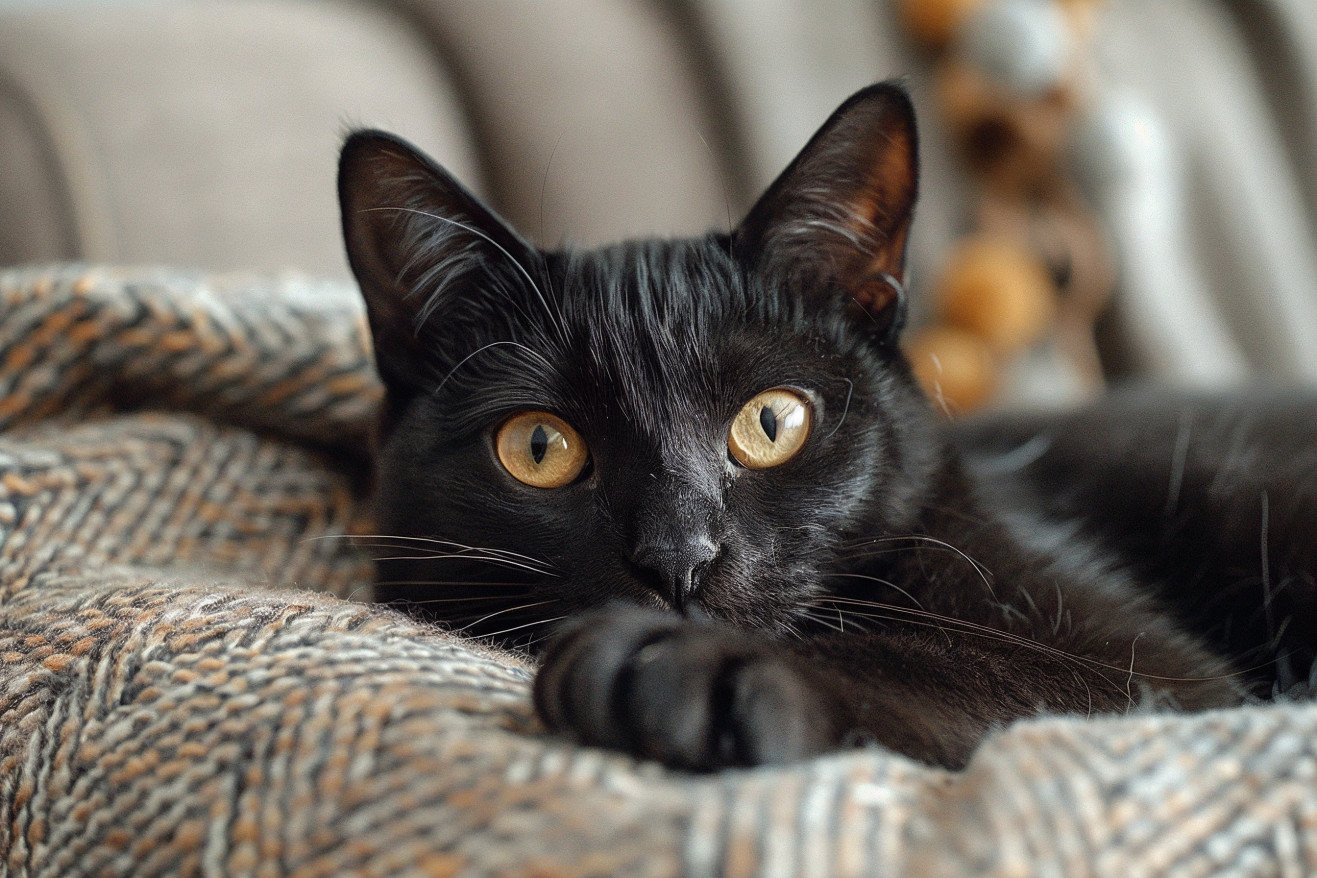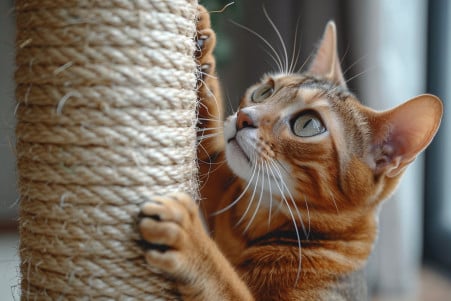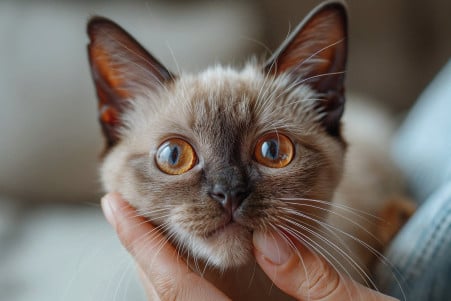Why Do Cats Bite Their Nails? Understanding This Quirky Behavior
25 April 2024 • Updated 25 April 2024

From kneading your lap to biting at their claws, learning why cats bite their nails can help you better understand this common but quirky behavior. When cats bite their nails, they're actually grooming themselves and removing the dead outer layer of their claws to keep them sharp for hunting, climbing, and self-defense. This behavior is a direct result of their wild ancestors, who had to keep their claws in top shape to survive.
This article will explore the scientific evidence provided by veterinary professionals, animal behaviorists, and evolutionary biologists to explain why cats bite their nails. By looking at the anatomy of a cat's claws, their grooming patterns, and the evolutionary history of the behavior, you'll come away with a better understanding of this feline quirk. This knowledge can also help cat parents ensure their pets have the right scratching surfaces and maintain good nail health.
Why do cats bite their nails?
Cat Claw Anatomy and the Purpose of Nail Biting
Understanding the anatomy of a cat's claws can help explain why nail biting is an instinctive behavior. According to Cats.com, a cat's claws are made up of an outer layer of keratin that surrounds a central "quick" that contains nerves and blood vessels. The outer layer constantly grows and sheds, so it needs to be maintained.
Nail biting is a key part of this maintenance, as it helps cats remove the old, frayed layers of the outer claw sheath. According to PetMD, "When we see a cat cleaning its paws, it may chew on its nails or around its paw pads to get rid of dirt, litter, or other debris." This removes the old, frayed layers and exposes the new, sharp growth underneath, ensuring the claws are always sharp and ready for action.
This behavior is rooted in evolution, as cats' wild ancestors needed sharp claws to hunt, climb, and protect themselves. As Catster explains, "Often, the outer layer may become frayed and damaged, and your cat will pull away the top layer to expose the cleaner, sharper layer underneath." This is why nail biting is an important part of a cat's instinctive grooming routine.
Cats and Nail Biting: A History of Grooming
Nail biting is one of the many grooming behaviors that cats perform on a regular basis. In addition to nail biting, other grooming behaviors include licking, scratching, and shedding. According to Catster, cats are fastidious groomers and spend a lot of time each day grooming themselves. When they groom themselves, they often bite and pull at their nails to get rid of any dirt or dead skin.
This is important to ensure that their claws are in good condition and ready for whatever they need them for, whether it's hunting, climbing, or self-defense. In fact, Cats.com states that "Cats chew their nails to help pull off the old outer nail husks, revealing the sharp new claws underneath. This is part of the continuous cycle of nail renewal." Watching a cat groom itself can help you understand the natural and instinctual reasons behind nail biting.
How to Stop or Prevent Your Cat From Biting Their Nails
If you're concerned about your cat's nail-biting behavior, there are several things you can do to help them stop or prevent the behavior from occurring.
While some nail-biting is normal, if your cat is biting their nails more than once a day, or if they're showing signs of paw irritation, such as redness, swelling, or hair loss, you should contact your veterinarian. According to RexiPets, causes of excessive or abnormal nail-biting can include injuries, infections, allergies, stress, anxiety, or boredom.
To help your cat stop biting their nails, you can focus on environmental enrichment, stress reduction, and addressing any medical issues. If your cat's nail-biting is due to anxiety or stress, Cat in the Box LLC recommends using calming aids, such as pheromone diffusers. Regular nail trims and providing appropriate scratching posts can also help prevent this behavior, according to Kohepets.
How to Safely Trim Your Cat's Nails
In addition to helping to keep your cat's nails at a healthy length, regular nail trims can also help to keep nail biting under control. According to Purina, most cats need their nails trimmed every 2-4 weeks, but the exact frequency will depend on how much your cat uses its claws and how quickly its nails grow.
It's important to use cat nail clippers and to make sure that you don't cut the quick, which is the nerve and blood vessel that runs through the nail. The Humane Society recommends keeping styptic powder or cornstarch on hand to stop the bleeding if you accidentally cut the quick. PetMD says that you should only cut the sharp, curved tip of the nail and that you should avoid cutting into the quick, which is pink in color.
You can help your cat get used to nail trims by using positive reinforcement and treats, as Martha Stewart explains. If you follow these guidelines, you should be able to keep your cat's nails healthy and possibly even reduce the frequency of nail biting.
Overgrooming and Fur Chewing: Potential Links to Nail Biting
Some cats may exhibit excessive grooming behaviors, including chewing or pulling out their fur, which could be related to nail biting. According to the VCA Animal Hospitals, in cats, "excessive sucking and chewing, self-directed aggression such as tail chasing or foot chewing, overgrooming or barbering of hair and possibly feline hyperesthesia may all be manifestations of conflict, and may become compulsive disorders in time."
Overgrooming can have medical causes like allergies, skin irritations, or pain, as well as behavioral causes like stress, anxiety, or boredom. As Catster explains, "Overgrooming can have medical causes such as skin allergies, but it can also be caused by stress and anxiety." Cats may overgroom or chew their fur as a way to release calming endorphins or cope with underlying issues.
Signs of overgrooming include bald patches, red or irritated skin, and tufts of fur being pulled out. According to POPSUGAR Pets, "Balding most often is caused by overgrooming, but it can also be caused by parasites of the skin, a bacterial or fungal skin infection, thyroid conditions, urinary issues, autoimmune diseases, or nutritional deficiencies." Addressing the root causes of overgrooming, whether medical or behavioral, may also help manage excessive nail biting in some cases.
Conclusion: Why Cats Bite Their Nails
Nail biting is a natural and instinctive behavior for cats, and it can be traced back to their evolutionary history and grooming behaviors. Knowing why cats bite their nails can help pet parents make sure their cats have access to the right kinds of scratching materials and understand the importance of proper nail care. That said, while excessive nail biting can be a sign of a larger problem, regular nail biting and trimming are important for a cat's health.
Understanding and accepting this natural feline behavior can help pet parents better understand and bond with their pets. After all, accepting and understanding a cat's natural behaviors, including nail biting, is an important part of being a good pet parent.


